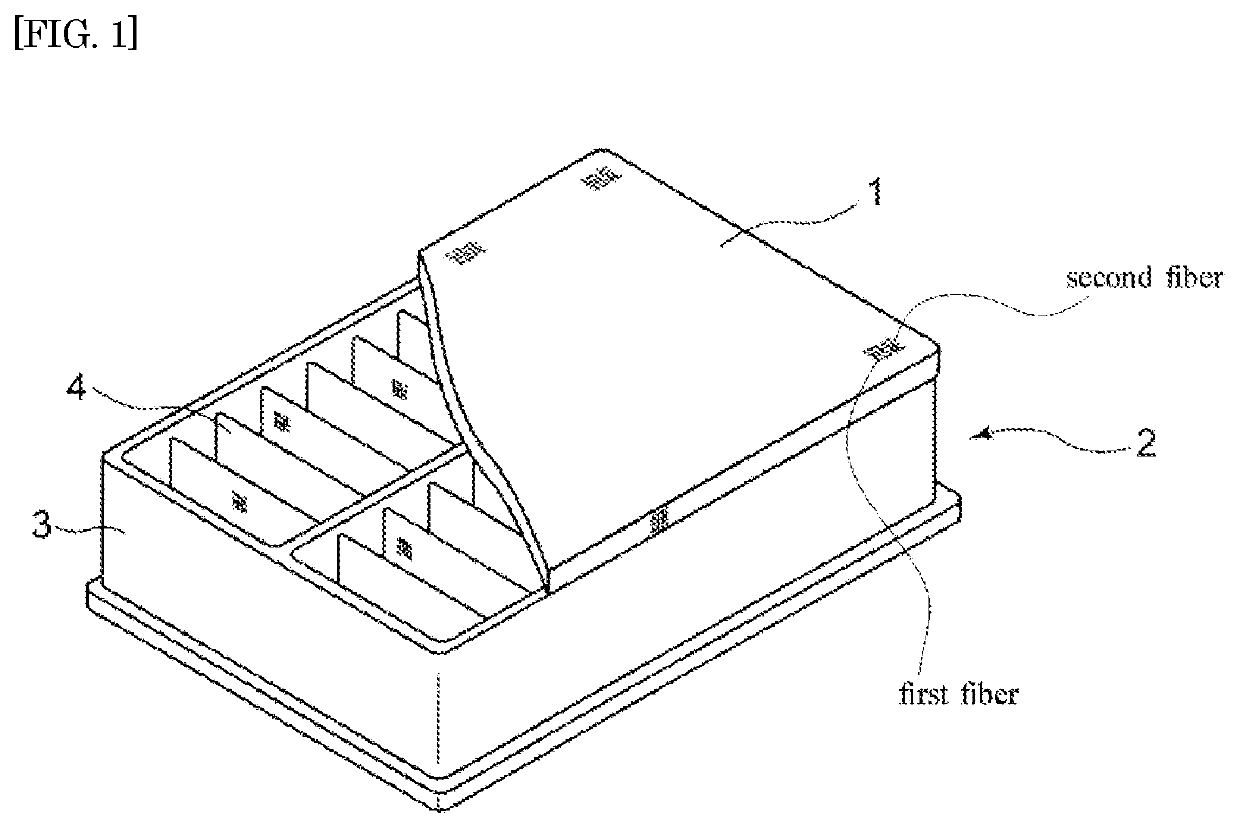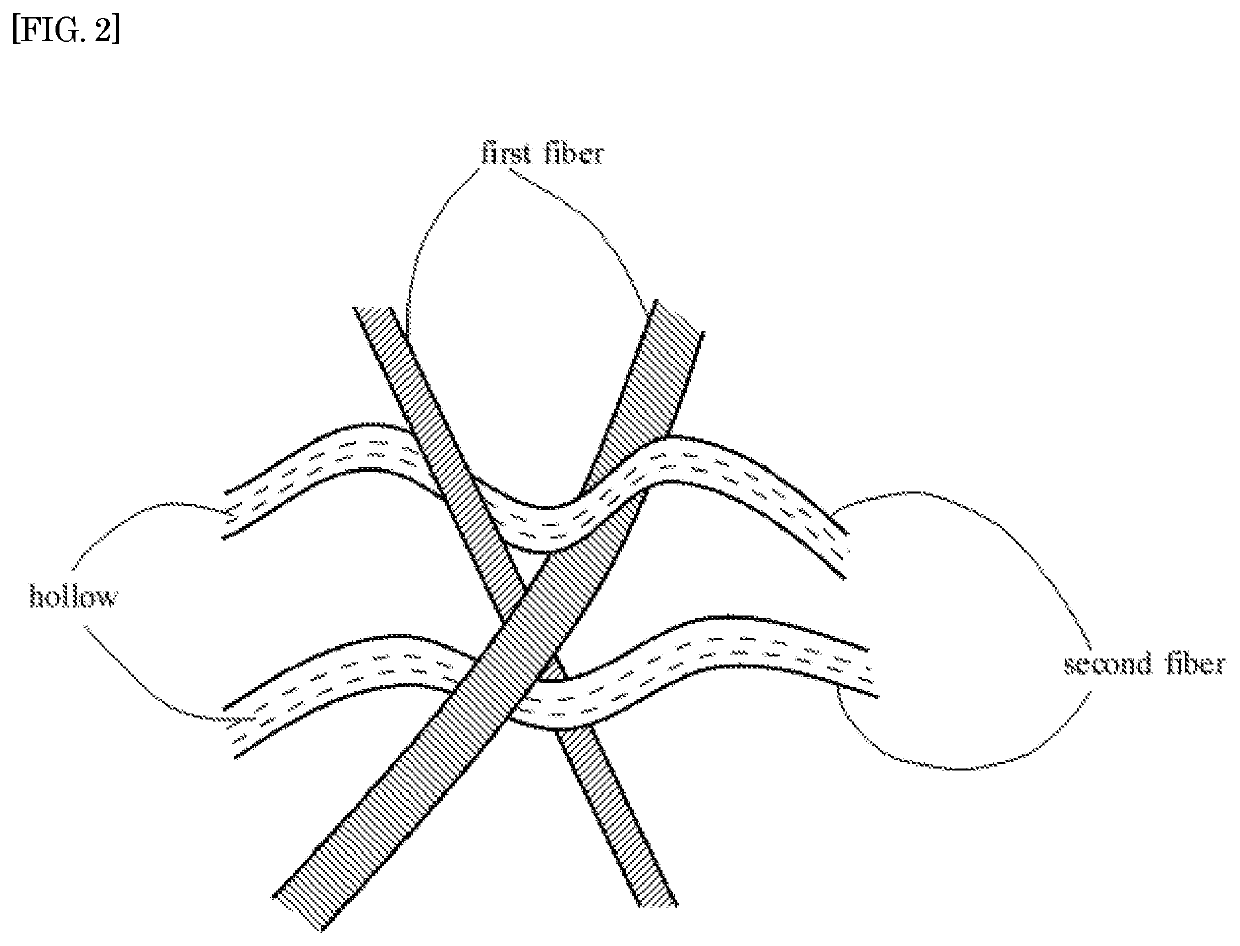Pre-air-filter for internal combustion engine
a technology for internal combustion engines and filters, applied in the direction of combustion-air/fuel-air treatment, filtration separation, separation processes, etc., can solve the problems of accelerating clogging, inability to achieve the intended purpose of reducing the frequency of filter replacement, etc., to achieve low melting point, improve the efficiency of filtration, and reduce the complexity of meshes in the planar direction
- Summary
- Abstract
- Description
- Claims
- Application Information
AI Technical Summary
Benefits of technology
Problems solved by technology
Method used
Image
Examples
example 1
[0119]As a high melting point fiber, 20% by weight of a hollow actualized crimped polyester fiber (polyethylene terephthalate (PET), melting point of 260° C., fineness of 6.6 dtex, fiber length of 51 mm, crimp degree of 20%, the number of crimps of 9 / inch, degree of hollowness of 27%), 15% by weight of a first low melting point polyester fiber (the core was PET, the sheath was modified polyester (L-PET), melting point of 110° C. glass transition temperature of 60′C, fineness of 4.4 dtex, fiber length of 51 mm), and 65% by weight of a second low melting point polyester fiber (the core was PET, the sheath was modified polyester (L-PET), melting point of 110° C., glass transition temperature of 60° C., fineness of 17 dtex, fiber length of 51 mm) were each measured, and blended, and were thereafter subjected to carding and then cross wrapping, to obtain a stacked fiber web. The stacked fiber web was needle-punched from one surface side by needles of the needle size of 40 (manufactured b...
examples 2 to 7
, Comparative Examples 1 to 2
[0120]Examples 2 to 7 and comparative examples 1 to 2 were each implemented in the same manner as in example 1 except that types and amounts of a high melting point fiber and a low melting point fiber were changed as indicated below in Tables 1 to 2, and conditions for needle punching were changed as indicated in Tables 1 to 2.
[0121]Fibers used in these production examples were as indicated below.
[0122]The “hollow actualized crimped fiber (conjugate)” is a hollow crimped fiber having a side-by-side structure, is formed from polyethylene terephthalate (PET), and has a melting point of 260° C., a fineness of 7.7 dtex, a fiber length of 51 mm, a crimp degree of 16%, the number of crimps of 8 / inch, and a degree of hollowness of 10%.
[0123]The “non-hollow fiber” is a solid crimped fiber which is formed from polyethylene terephthalate (PET), and has a melting point of 260° C., a fiber length of 51 mm, and a crimp degree, the number of crimps, and a fineness whi...
PUM
| Property | Measurement | Unit |
|---|---|---|
| melting point | aaaaa | aaaaa |
| melting point | aaaaa | aaaaa |
| melting point | aaaaa | aaaaa |
Abstract
Description
Claims
Application Information
 Login to View More
Login to View More - R&D
- Intellectual Property
- Life Sciences
- Materials
- Tech Scout
- Unparalleled Data Quality
- Higher Quality Content
- 60% Fewer Hallucinations
Browse by: Latest US Patents, China's latest patents, Technical Efficacy Thesaurus, Application Domain, Technology Topic, Popular Technical Reports.
© 2025 PatSnap. All rights reserved.Legal|Privacy policy|Modern Slavery Act Transparency Statement|Sitemap|About US| Contact US: help@patsnap.com


